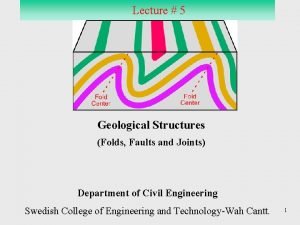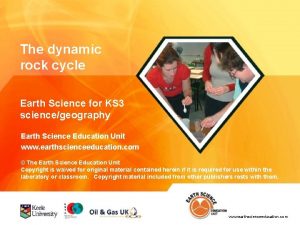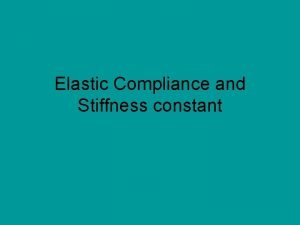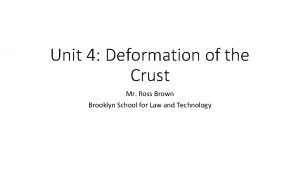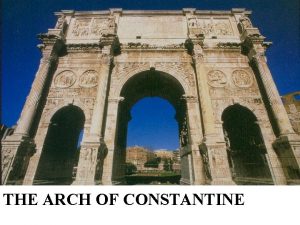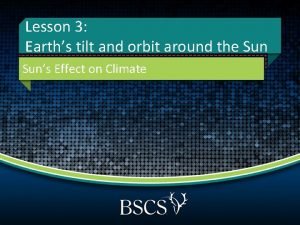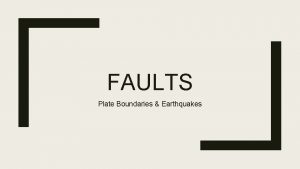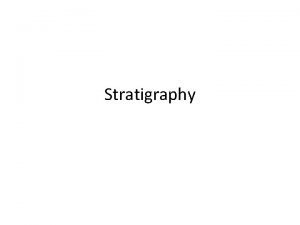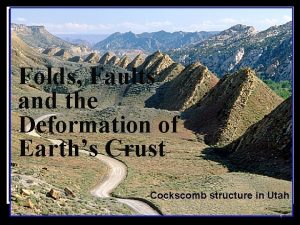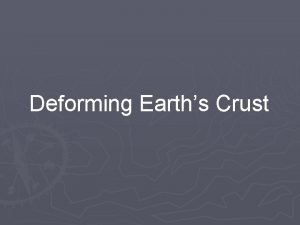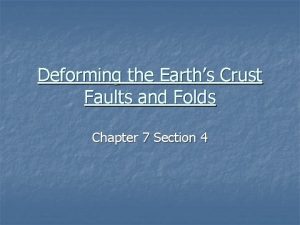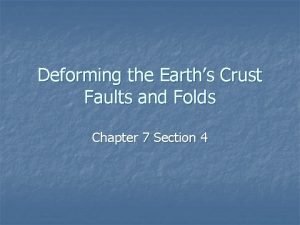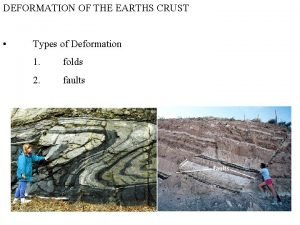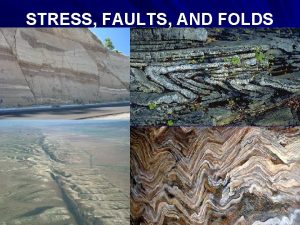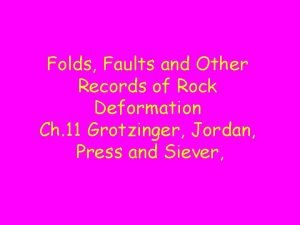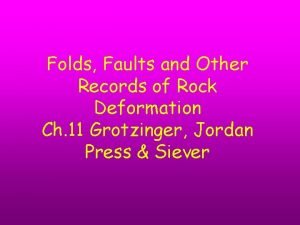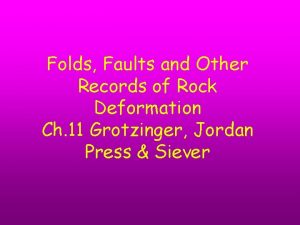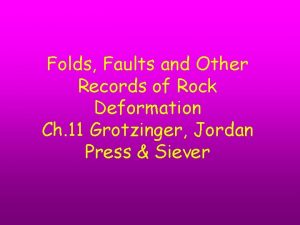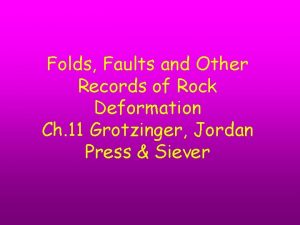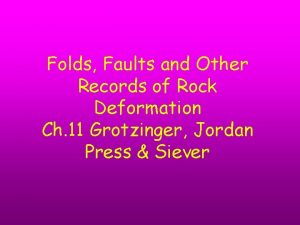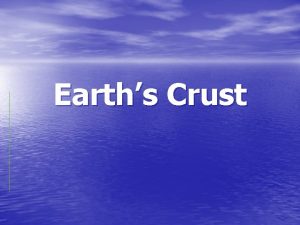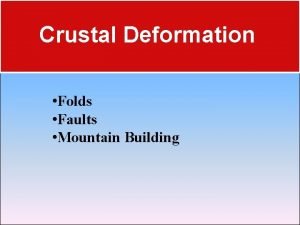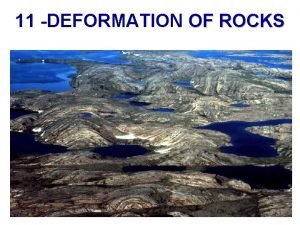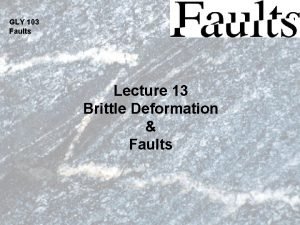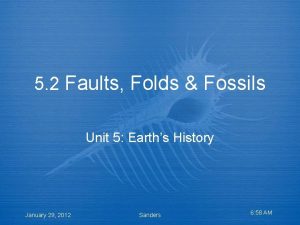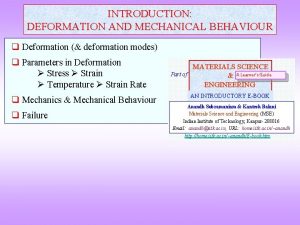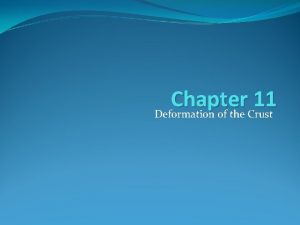Folds Faults and the Deformation of Earths Crust


































- Slides: 34

Folds, Faults and the Deformation of Earth’s Crust Cockscomb structure in Utah 1

Pre-crash What Happened to this car? 1984 Post-crash It was deformed (folded) because of the collision 2

Coincidentally, note how this car is so much more safe The car deformed like an accordion while the passenger compartment did not suffer. That is possible because the front part of the car absorbs the stress by folding. 3

Stress vs. Strain The force applied to some body is the stress. The changes to that body are the strain that is recorded. You work very hard lifting things. Your back is strained. 4

Silly Putty absorbs the Stress that is applied to it when it hits the floor. However, the Strain is released when it bounces away from that Stress. Silly Putty is elastic, it bounces if it were dropped on the floor. 5

The Slinky is Elastic i. e. it can be stretched and stretched but it snaps back to its original length. 6

The 1 st Type of Stress: n Compression: occurs when crustal rocks are squeezed together n Can reduce the volume of rocks, can push the rocks higher up or deeper down into the crust 7

The 2 nd Type of Stress n Tension: the force that pulls rocks apart n Rocks that are pulled apart by tension tend to become thinner 8

The Final Type of Stress n Shearing: pushes rocks in opposite horizontal directions n These rocks bend, twist, or break apart as they slide past each other. 9

The Deformed Earth n Plate tectonics and the movement of lithospheric plates causes the Earth’s crust to DEFORM…. “No, no, don’t look at me!!! I’m hideous!!” 10

Isostasy and the Mattress Test n Have you ever seen the commercial for foam mattresses where they place a glass of red wine on one side and a man jumps up and down on the other side? n Isostasy: the balancing of up-and-down movements of the earth’s crust. 11

What happened to these rocks? What evidence do you see, which caused your interpretation? 12

Which of the following types of tectonic forces tends to squeeze and shorten a rock body? A. B. C. D. compressive forces shearing forces tensional forces all of the above 13

Which of the following types of tectonic forces tends to squeeze and shorten a rock body? A. compressive forces B. shearing forces C. tensional forces D. all of the above This looks like the safe car because of how it folded 14

What type of forces dominate at convergent plate margins? compressive forces B. shearing forces C. tensional forces D. torsional forces A. 15

What type of forces dominate at convergent plate margins? A. compressive forces B. shearing forces C. tensional forces D. torsional forces 16

The San Andreas Fault is a result of what type of forces? A. B. C. D. compressive forces shearing forces tensional forces all of the above 17

The San Andreas Fault is a result of what type of forces? A. compressive forces B. shearing forces C. tensional forces D. all of the above 18

Which of the following statements best describes the behavior of rocks during deformation? A. Brittle materials deform by faulting, whereas ductile materials deform by folding. B. Brittle materials deform by folding, whereas ductile materials deform by faulting. C. Both brittle and ductile materials deform by faulting. D. Both brittle and ductile materials deform by folding. 19

Which of the following statements best describes the behavior of rocks during deformation? T- High or Low? P- High or Low? ductile materials deform by folding Marble is special because it can be Brittle or Ductile depending on Pressure and Temperature Brittle materials deform by faulting T- High or Low? P- High or Low? 20

These are Sedimentary Rocks m y u e s h t T The principles of Original Horizontality and Superposition apply- h e v a be en folded But these layers are not any longer Horizontal 21

These Rocks were Brittle so they were fractured to form a Fault a a b b The faults were not caused by Compression Forces 22

These Rocks were Brittle so they were fractured to form a Fault The faults were not caused by Compression Forces The length of the rock formation is greater than the original length because of the type of fault The faults were caused by Tension a a b b 23

More FOLDED Sedimentary Rocks But HOW MUCH have they been folded? or How can one measure the angle that they have rotated from the original horizontal? 24

Measuring the orientation of a surface 25

Rocks also have a Strike and Dip Strik e- th e di rect ion to w hich the hori z onta l line poin ts 26

Geological Map shows the rocks exposed on surface over which you are walking 27

3 - D View of Geological Structures Plan view i. e. the surface that one looks down to see ly l ca ti r ve n e be sion ve ro a h le ks ura c t ro na e th y or re a e w h w igh ew w h i v e n e th r a op fo r c h ut ug O ro th The same formation t u c 28

Ductile Materials and Deformation They undergo Plastic Deformation i. e. they change shape and do not break but do not return to their original form 29

Combinations of Stresses 30

A Rift Valley formed by Extension 31

Fresh Scarp Face showing surface exposed by a very recent earthquake * * 32

Symmetrical Folds 33

34
 True vocal folds and false vocal folds
True vocal folds and false vocal folds Folds faults and joints
Folds faults and joints Make your own folds and faults
Make your own folds and faults Most abundant element on earth
Most abundant element on earth Plasticity in earth's layers
Plasticity in earth's layers Lithosphere
Lithosphere Earths crust
Earths crust Elastic compliance and stiffness constants
Elastic compliance and stiffness constants Anterior and posterior axillary fold
Anterior and posterior axillary fold Anticline and syncline folds
Anticline and syncline folds Nasolabial fold filler before and after
Nasolabial fold filler before and after Inner core and outer core
Inner core and outer core Earth layers foldable
Earth layers foldable Earths roation
Earths roation Whats a natural satellite
Whats a natural satellite What makes one biome different from another?
What makes one biome different from another? Whats earths moon called
Whats earths moon called Thickest layer of the earth
Thickest layer of the earth Earths early atmosphere contained
Earths early atmosphere contained Earths major crustal plates
Earths major crustal plates Earths orbit seasons
Earths orbit seasons Brown earth soil profile
Brown earth soil profile Study of earth's physical features
Study of earth's physical features Earth's honey
Earth's honey Whats the name of earths moon
Whats the name of earths moon Continental drift theory
Continental drift theory Where
Where Spring earth tilt
Spring earth tilt Layers of the atmosphere
Layers of the atmosphere Describe the true shape of earth's orbit
Describe the true shape of earth's orbit Arch of constantine dimensions
Arch of constantine dimensions What does earths tilt do
What does earths tilt do Earths boundaries
Earths boundaries 4 spheres of the earth
4 spheres of the earth Law of unconformities
Law of unconformities

